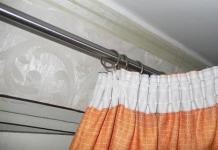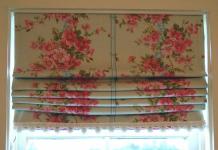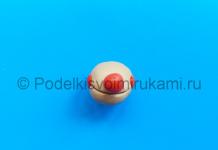Plastic windows have long and, apparently, entered our everyday life for a long time. They have a number of indisputable advantages: they perfectly protect against urban noise and dust, retain heat, and do not require regular painting. But many owners are interested in which curtains are most suitable for such windows, especially when you consider that they are not recommended to be drilled to secure any structures.
Recently, Velcro curtains on a plastic window have become increasingly used. They are practical, easy to use, modern, and besides, they are easy to make with your own hands. The adhesive tape (velcro) used in this case consists of two strips. With their help, cuts of textiles are glued together. Velcro curtains on a plastic window, the photos of which we posted in this article, can be matched to any interior.
Types of curtains
If you want to decorate plastic windows in a modern way, in accordance with the latest design developments, we advise you to pay attention to several popular models.
Corrugated
For the manufacture of such a model, fabrics with an antistatic coating are used, which are collected in an accordion when it becomes necessary to roll up the curtain. Depending on the design, the window can be slightly opened both from below and from above.
Roman
These curtains, when unfolded, are a straight piece of fabric, but if necessary, starting from the bottom, they are gathered into horizontal deep beautiful folds. This model is quite easy to sew on your own.

Rolled
This is a great solution not only for rooms, but also for a loggia or kitchen. They are made of fabric, and fastening is done with Velcro. There are closed and open types of such models. Open curtains are fabric twisted into a dense roller, placed above the window. Closed in a folded form are in a special cassette and are completely invisible.
Velcro curtains on a plastic window: a master class
Decorating a window in a stylish and original way is not difficult at all on your own. We want to tell you how to use Velcro on a plastic window with your own hands. Our master class is addressed to beginners in sewing and is an alternative to roller blinds and blinds.
You will need:
- textile;
- glue;
- threads;
- Velcro;
- rep tape;
- scissors;
- pencil and ruler.
First of all, you need to accurately measure the length and height of the window. Glue Velcro with spikes on top of the window. To do this, you can use any glue suitable for gluing fabric and plastic. If you don't want to apply glue to the plastic, Velcro can be attached to it, but in this case the curtains must be made of a very light fabric.

The fabric is cut out taking into account seam allowances. The soft part of Velcro is sewn to it. On a window that opens for ventilation, it is advisable to sew Velcro both from below and from above. And on a blind window, it is enough to fix it only from above. In this case, the lower part of the curtain is hemmed with a seam five centimeters wide. It must be transparent.
Edge processing
It is necessary to pay attention to the side of the curtain. We recommend taking a "cobweb" and using an iron to solder the sidewalls. This gives additional rigidity on the sides, the curtain hangs more evenly. We solder with an iron once, then we bend the fabric with a “cobweb” and solder it again. It turns out a very neat and beautiful side of the curtain.
You can hang the finished product on the window, and insert a wooden or plastic plank of the desired size into the bottom seam. Thanks to her, your product will hang neater. If you plan to raise the curtains, then you need to sew a rep tape on top, from the front and back sides. We roll up the curtain from the bottom with a roll and tie it with bows.

Roman curtains
This type of curtains has a long history and fits perfectly into the interior of different directions and styles. They are easy to manage - pull the cord, and they immediately gather into beautiful wide folds. To make Velcro on plastic windows, you will need:
- textile;
- Velcro tape;
- metal or plastic strips;
- tailor's tape, close to the main fabric in color;
- weighting bar;
- several metal or plastic rings of small diameter (at the rate of 3 pieces for each pocket sewn on the wrong side);
- the cord is two and a half times the length of the curtains.
When pockets are sewn from a tailor's tape on the seamy side of the curtain, strips or metal rods should be inserted into them, a weighting bar is inserted into the lower pocket. A cord is passed through the rings sewn at the level of the pockets. Thus, you can make a curtain lifting mechanism with your own hands. It remains only to fix the product on the window.

Making a cornice
Velcro roller blinds are attached to plastic windows either directly or on a cornice equipped with Velcro tape. If you don't want to buy it, you can make it yourself.
To do this, you need a wooden bar, the length of which should be twenty centimeters longer than the width of the window, the same size Velcro tape (its hard part with spikes), acrylic sealant or “liquid nails”, 3-4 dowels (plastic) and the same number of self-tapping screws.
Determine the height at which you plan to fix the eaves. It can be located on the wall if your curtains are not long, or on brackets with an extension of about twenty centimeters, if the curtains are planned to be long, hanging freely and not touching the window sill.

The bar must first be processed with fine sanding paper and coated with stain or varnish, glue the tape and fasten with staples (construction). You can screw the bar with self-tapping screws directly through the tape. We have already said that the soft part of the Velcro is sewn to the upper edge of the Velcro curtain (on the plastic window). It remains only to attach the upper edge of the canvas to the eaves, and your design will be securely fixed.
Finished Models
Accuracy and simplicity characterize the roller blinds on the plastic window "Leroy Merlin". Mounting on double-sided Velcro and staples does not violate the integrity and sealing of the window. The weighting agent, located at the end of the roller shutter made of fabric, outwardly almost does not differ from the main surface of the curtain. But the main thing is that for their installation you do not need to drill plastic and use self-tapping screws.
If you want to install a light roller blind, then Velcro is fine for fastening, but do not forget to degrease the surface of the plastic on which it will be fixed. Velcro curtains on the Leroy Merlin plastic window can be installed close to the window, directly on the sashes, at a short distance from it, or on remote brackets.

The cassette-roll mechanism of a well-known brand will ensure easy and reliable operation of the curtains for the entire time stated in the warranty.
Choice of curtains
When choosing Velcro curtains in Leroy Merlin stores, first of all, consider the color of the wallpaper in the room. If they are plain, then curtains with a pattern are more suitable for you, if the wallpaper is with patterns, then opt for plain products. Remember, their color should be a tone lighter or darker than the wallpaper, otherwise they will merge. The combination of cold and warm shades, as well as plain and patterned curtains, looks interesting.
Roller blinds with Velcro on the plastic window "Leroy Merlin" are efficiency and simplicity, an elegant and non-standard solution for a modern home. Ease of care and modern look will delight the owners. A huge selection of colors and sizes will allow you to choose the perfect option.
How to use curtain tapes is a natural question that arises immediately after the housewives find out what this device is. Indeed, at first glance it is not clear how using a translucent tape and ribbons you can get original folds on the curtains, how to fix it and what to do next. But it’s worth a little understanding of the topic, and beautifully draping the window is not difficult.


Peculiarities
A curtain tape is a decorative soft fitting used to create folds of different widths and configurations on fabric. Its use for window decoration has been very common lately among designers, needlewomen and curtain tailors, because this inconspicuous detail can turn even the most boring curtains into chic curtains.
The most convenient thing about it is that it is not made of a stretchy fabric, but of a dense material, due to which it is easy to sew on a typewriter to the fabric, and folds can be made of any density. You can adjust their size and number with several laces passed through the entire length of the tape.




Curtain tape has the following features:
- Simplifies the process of sewing curtains;
- Does not require sewing loops to fix the fabric on hooks - these loops are already provided on the tape;
- Allows you to beautifully drape fabric of any density and texture;
- Allows you to decorate windows in an original way;
- It makes it possible to adjust the width and length of the curtains without resorting to radical methods of cutting and hemming the fabric;
- Variable width - from 3-4 centimeters to 15-16;
- Even the transparent tape is made of a durable material that does not crumble or lose its shape;
- Accessories do not fade and do not deteriorate over time;
- Washable in any mode, does not shrink;
- Easily tightened with cords;
- High-quality assembly gives clear and neat folds.




Kinds
There are several parameters according to which the curtain tape is divided into types: material density, width, type of fastening, method of fabric drapery.
According to the density of the material, they distinguish: a transparent tape for light fabrics (organza, tulle, veil, mesh), opaque for heavier materials.
Cotton tape is used in cases where you do not need to try to hide it from prying eyes. It is much more convenient for sewing, even an amateur seamstress can handle it in a fairly quick time. She also has her own characteristics - cotton can shrink up to 15% after the first wash. Given this, before flashing, the tape must either be washed and dried, or thoroughly steamed with an iron.


The width is divided into narrow, medium and wide tapes. This parameter is not chosen at random, but in accordance with the location and type of cornice and the intended result.
The minimum width is intended for cases where:
- The cornice is of a closed type, that is, the junction of the hooks with the top of the curtain is behind the decorative strip;
- The cornice is located in a niche;
- Instead of a decorative strip, the upper part of the curtain is hidden by another element, for example, a lambrequin.


- The cornice is open or has a non-standard shape:
- There are a small number of hooks or fasteners on the curtain. This can lead to sagging fabric on a thin tape, and a wide one will successfully support the top of the curtain without sagging;
- The folds at the top of the curtains are the main decoration.




Varieties of tapes for curtains according to the type of fastening are more variable, according to the method of fastening (sew-on and hot-melt adhesive) and according to the method of fixing on the cornice (with hooks, eyelets and Velcro):
- Ribbon with loops for hooks. It is a soft fitting for the formation of folds, along the upper or middle line of which there is a series of solid loops for hanging the fabric on curtain hooks. If the loops are 1-2 rows, they are intended only for hanging curtains, and 4 rows or more make it possible to adjust the height of the curtains without bending and hemming;
- Grommet or with fastening on eyelets. This is a kind of tape with metal rings for pipe cornices of different diameters. The rings are simply strung on the curtain, and the folds are formed by hand. Another variety is a ribbon with a longitudinal transparent pocket in the center, through which the curtain rod is threaded through;
- Velcro tape or kritz-kratz. For fixation, it has a wide sticky strip, similar to Velcro on clothes;
- Self-adhesive. This is a rigid curtain tape, along the top of which there is an adhesive strip for fastening;
- Combined. A tape that combines several mounting options. Most often these are loops and Velcro;
- Hot melt. Fastening occurs due to the heating of the adhesive strip with an iron. It works the same way as patches on clothes on an adhesive basis: when heated under the influence of high temperature, the composition becomes liquid and sticks the tape to the curtain, and then cools down again, reliably connecting the two layers of fabric together. There are several types: with one strip along the upper edge, with stripes along the upper and lower edges at the same time for better fixation.
- For string cornice. A string cornice is similar to a pipe cornice, but its diameter is much smaller - it is a thin metal wire stretched over a curtain.
You can fix the curtain tape on the string cornice with the help of loops, Velcro, eyelets, hooks.



Drapery
The most important characteristic of curtain tape is the type of folds it gives. They are very diverse and look different on curtains depending on the density of the fabric.
The following types of drapery are popular:
- Columns. These are uniform rows of neat folds that are perfectly similar to each other. Their number and degree of density depends on how tightly the laces are pulled together on the tape;
- Puffs. Unlike columns, it gives the opposite effect - uneven folds. When assembled, it resembles a “waffle” surface, therefore “waffle” is the second name for this type of drapery;
- Pencil. Classic narrow repeating pleats. The simplest, fastest and most versatile type of fold;



- Glasses (glasses, glasses). They got their name for the characteristic appearance of the folds, which resembles an elegant narrow and elongated glass on a leg. The width of the "glass" depends on how tightly to collect the folds. They look the most voluminous of all available;
- Bows. Forms neat laconic bows on the fabric. Beautiful, unusual and done with just a couple of hand movements;
- Butterfly. Diamond-shaped pleats formed with four cords on the tape;



- Counter folds. Overlapping creases are formed with the help of two tucks that overlap each other.
- Fan, or the so-called French assembly. When the tape is pulled together, graceful folds are formed on the fabric in the form of a fan of 4-5 feathers.
The assembly process is not complicated in itself, but requires compliance with some nuances.


You need to pull the laces carefully, it is advisable to do this at the same time on both sides. With a large width of curtains or tulle, it will be easier to do this together.
If there is no assistant, one side must be fixed with improvised means and gathered in turn. The final step is to evenly distribute the folds at the same distance from each other.
At first it is difficult to do it “by eye”, but a centimeter tape will help out here. Having measured the total length of the curtain, it must be divided by the number of folds, then the same distance between the folds will be obtained and the cornice will take on a neat appearance.
In the process of pulling the cords, they lengthen quite strongly. In order not to confuse them with each other, especially in the amount of 3-4 pieces, you should use a paper sleeve for winding or special plastic clamps, which are sold in many departments with accessories and textiles.


A very common mistake with hanging hooks. It often happens that after assembly they are hung not on loops, which are just for this purpose, but on a stretched cord, which forms a pattern on the fabric. It is not right. When the hooks are arranged in this way, the curtains will sag under their own weight, and the beautiful folds will warp.
It is important to take into account such an indicator as the "assembly factor" of curtains and ribbons. This value is the ratio of the dimensions of the curtain and curtain braid, on which the initial length of the tape before assembly depends. It is individual for each type of drapery:
- pencil - 2-3.5;
- bows - 2.5-3;
- puffs - 1.5-2.5;
- fan -2.5;
- glasses - 2-3;
- eyelets - 1.6-2.5.
These values are not final, they can be reduced or increased up to one, depending on the desired density of the folds. The length of the braid, taking into account the coefficient, is calculated by the formula: the length of the cornice x the assembly coefficient + 10 centimeters for the hem of the tape along the edges. That is, for example, with a cornice length of 3 meters, and a coefficient of 2.5, after adding a hem, you get 7.6 m of curtain tape.


How to choose?
Properly selected braid for assembly is the key to an excellent result. There are several main criteria by which you need to choose the right braid:
- Cornice type. For cornices located in a niche or under a decorative strip, a tape of medium width (about 6 centimeters) will suffice, since the hooks will still not be visible on the front side. For open-type cornices, a wide cotton tape with additional rows of loops is more suitable. Fasteners will also not be visible "from the face" of the product;
- Attachment type. The tape must correspond to the possibilities of fastening on the eaves: on hooks, eyelets, Velcro. Velcro-velcro is otherwise called a contact tape, which consists of two halves: loop and hook. Absolutely any kind is convenient for a string cornice; eyelets are more suitable for pipe cornices, tape with loops is more suitable for a cornice with hooks; ceiling cornice is also convenient for different types of fastening;
- Portier fabric. The material determines the degree of transparency of the ribbon. In order for the front side of the product made of light translucent fabric to look aesthetically pleasing, the curtain tape should also be chosen from translucent fabric. For denser and heavier materials (for example, jacquard fabrics), fittings made of dense cotton are intended;
- Room design. The general style direction determines the type of drapery and the degree of its complexity. For classic-style interiors, simple solutions (pencil, counter pleats) are more suitable, while historical styles are characterized by more original views, such as fans or glasses;
- build factor. The longer the cornice and the denser the fabric, the wider and stronger the tape should be. In the event that you plan to place two curtains on one tape, you need to calculate the length of the tape for each separately, then add 10 cm and summarize the result;
- Additional decor. Simple pleated curtains no longer surprise anyone. The last word in room design is the use of lighting. It can be installed both on a tape and on a cornice to create additional volume on the play of light and shadow and visually increase the height of the ceiling. It is desirable that the backlight be LED, this will significantly save energy costs.




How to sew?
The main advantage of the curtain tape is that it can be sewn at home if you have a sewing machine. Step by step instructions include the following steps:
- The right choice of fabric and appropriate curtain tape.
- Curtain or tulle treatment, depending on what was chosen for the combination with the ribbon. This applies to those types of fabrics that have a crumbling, non-factory bottom or side edge. In this case, it must be processed with a seam with a double hem. For ready-made curtains, to which you only need to sew a tape, no manipulation is required.
- At the third stage, you need to sew the ribbon and fabric together. To do this, you need to attach the curtain tape to the upper edge of the curtain or tulle, to the front (this is important) side with pockets down; fold inward the side edges of the tape. Then sew the tape with one line from the bottom for a width of up to 4 cm, and from 4 - with two lines (an additional one is laid in the middle of the tape). All stitches are sewn in the same direction, not in a zigzag; the top edge is left unstitched.
- At the next stage, you need to bend the stitched strip of fabric with a tape with an allowance of 0.5 cm to the wrong side. Thus, it will be in the right place in the right position, with pockets on top, so that it is convenient to put the fabric on hooks in the future. Gently straightening the fabric so that the edges match, you can pin it with pins and sew the bottom line. This sewing method eliminates the need to pre-process the upper edge of the fabric.
- The curtain is ready, it remains only to pull the laces to form folds, distribute them at equal distances and attach hooks (if the type of fastening implies them). The side pockets with this method remain unstitched, so you can fasten the laces into ribbons in them.




Second way also begins with the choice of fabric and processing the edges of the product. Next, the upper edge of the curtain or tulle must be folded to the wrong side to the width of the curtain tape plus 0.5 cm. Before sewing on the tape, it is folded inward from both edges by 2 cm, after releasing the laces. Having attached the tape close to the side edge, you need to make a mark, and then sew on a typewriter.
This method also does not take much time, but 2 or 3 seams will be visible on the front side of the product instead of one.


Third way:
- Fold the top edge of the fabric to the width of the curtain tape.
- Put a curtain tape on the hem with pockets up, stepping back from the top edge of 0.5-1 cm. At the same time, at the edges, the tape should be 3-4 cm shorter than the fabric (depending on the width of the double hem - 2x2 or 1.5x1.5 cm).
- Lay a basting with contrasting threads.
- Lay machine line. All seams should start from one end.
- Finish the side cut with a double hem to the base of the tape so that the gathering cords run freely and are not stitched to the fabric.
With this method, the side hem turns out to be as accurate as possible, as if the curtain was purchased immediately with the tape.




How to calculate the length?
Sometimes even one extra centimeter of curtains can spoil the neat look of the window. But you can still shorten the curtain - hang the cornice a little higher or cut off the excess and hem it with a sewing machine, but making it longer is a very difficult task. In order not to have to find various ways to transform unsuitable curtains, you need to immediately accurately and correctly perform all the calculations.
Self-adhesive tape is a simple and practical fastener made from polyester and nylon. It is presented in the form of a fastener, one part of which is equipped with micro hooks, and the second part is equipped with micro loops made of monofilaments (polyamide). When in contact with each other, the textile parts cling to form a strong bond. The name "Velcro" came precisely because of the ability of instant gluing.
Self-adhesive tape - where and how is it used
Velcro has found a very wide application in everyday life and in the manufacture of garments. Relatively recently, it began to be used as a fastener for curtains, lambrequins and various types of curtains. The convenience of self-adhesive tape was immediately appreciated - the hostess does not need to put on numerous loops on the hook, keeping her hands at a height.
Having installed the tape on the cornice, its second part is placed on the edge of the curtain. To close, you just need to press both elements against each other. The opening is made to break - taking hold of the edge of the strip, it is disconnected from the second part.
Advantages of fixing self-adhesive tapes:
- Velcro is installed using various methods: on the metal staples of the stapler, on adhesive compositions or with self-tapping screws on a special frame.
- Despite the soft fixation, Velcro creates a fairly strong grip.
- The tape can be cut to certain lengths, after which its edges remain intact and do not crumble.
- Made from nylon and polyester, Velcro is resistant to temperature changes and dirt. It can be washed, after which it retains its original qualities.
The universal clasp has found its application as a fastener for various types of curtains. It is convenient for both simple and light curtains, as well as Roman, Japanese curtains.
Velcro perfectly holds lambrequins, forming an even tight fit. The tape can be fixed on a plank, a plastic window frame, on cornices (open and closed), on a wall.
The use of this fittings freed the housewives from the tedious threading of loops into hooks. With Velcro, the whole process takes a few seconds.
In the online hypermarket "Shkatulka" you can buy self-adhesive Velcro tape at retail at quite affordable low prices, picking it up by color and width.
Among the methods used to fasten curtains, there are many. Among them are Velcro, with which you can install curtains from various materials.
Curtains with Velcro are convenient and practical, primarily because they do not require holes drilled in plastic or wood.
Strengthening on the cornice is a simple operation, and there are several ways to carry it out, among them:
- on ties and braid;
- drawstring and hinges;
- eyelets;
- hooks, clips and clothespins;
- Velcro.
The latter, according to many, is the simplest. This does not require special knowledge, large expenditures of money and time.
Velcro curtains, description, fastening features, design options
Velcro Velcro - as it is officially called - has confirmed its effectiveness. With its help, you can install curtains without a cornice on plastic and wooden windows. It is especially convenient to use them in small rooms, where the cornice can look bulky, and the curtain, which is not close to the wall, makes the room visually even smaller.

Using Velcro for small windows allows you to get rid of a bulky cornice
What is Velcro
This type of fastening is used quite widely: in the manufacture of garments, shoes, accessories and other goods. It consists of two tape elements: micro-hooks are located on one, and the same small loops are on the other. When both tapes come into contact, the hooks cling to the loops, sticking tightly to each other.

Self-adhesive Velcro tape or Velcro
Product Benefits
The convenience of Velcro is that they can be fixed on windows and in the absence of a cornice, which saves space and money. Other advantages include:
- long service life and preservation of technical characteristics;
- ease of installation and care: they are easy to remove, wash, dry and iron.
- Velcro curtains can be used for any interior and style direction.

Velcro fastening on a plastic window does not violate the integrity of the window
How to install curtains on a window without drilling
Traditionally, to hang curtains, you first need to install the curtain rod, having previously drilled holes in the wall. Then mount the holders for it and fix them securely.

Fastening individual sheets of Japanese curtains with Velcro
However, many novice home craftsmen are interested in how to attach a curtain to a plastic window, but avoid drilling. This can be done using the possibilities of fastening curtains with Velcro. This method of fastening can be used when installing:


Velcro hinged curtains are similar to ordinary curtains, to remove them it is enough to unfasten the Velcro
Do-it-yourself installation of Velcro curtains
Before proceeding with the design of the curtain with Velcro, you need to decide where to attach it: on the wall, plastic or wooden window, and then:
- cut a strip of fabric from 5 to 12 cm wide, depending on the purpose and density of the curtain;

We take measurements of the window with an allowance for Velcro and seams at the top and bottom

We cut out the curtains in size, bend the sides of the curtain, then the bottom of the curtain with the help of the soft part of the Velcro on the wrong side

For each curtain we sew 4 strings from the same or another fabric
- fold it in half and stretch along the entire upper edge with the right side out, iron;

To the top of the curtain on the front side, we pin a soft Velcro, measure 7 cm from the edge of the curtain, put one string under the Velcro from below, sew

We bend the Velcro to the inside and sew it, placing another 1 string
- sew on the soft part of the Velcro (you will need a tape without a sticky layer);

We glue the hard part of the Velcro on the wall and fasten our curtain
- fold the fabric along the seam and stitch as close as possible to the Velcro.

Drawstrings can be used to raise and lower curtains
After that, the front side of the fabric is covered with a bar, which also needs to be sewn.
The rigid part of the fastener is attached to the eaves and glued.

To fix the bottom of the curtain, we use a rigid Velcro along the edges.
Attention! If the curtain is light and it is supposed to be installed on a plastic window, additional use of the adhesive mass is not required.
How to hang a roman shade without drilling

The nuances of fixing a Roman blind with Velcro
One of the most popular types of curtains for a long time are the so-called Roman blinds. Today they are smooth fabrics with which you can quickly and beautifully decorate the room. At the same time, another advantage of these products is style versatility: they fit perfectly into any interior.

On the wrong side of the fabric, with the help of chalk or a piece of dry soap, we mark the places where the rings, the lines of folds and the fold are located.
Usually they are mounted on cornices; To do this, drill holes where fasteners are inserted and fixed. However, today, in order to hang this type of curtain, it is not necessary to drill a wall - you can use Velcro tape.

We process the side edges and the upper cut of the fabric, sew Velcro to the upper cut, on which the curtain will be attached
For this, in addition to the fabric itself, you will need:
- Velcro (soft part);
- plastic or metal strips that will imitate the cornice;
- bar for weighting, which is strengthened along the bottom of the product;
- an even number of curtain rings.

We install a wooden beam on the window frame

Using nails or a furniture stapler, we attach Velcro to the bottom of the wooden beam
The work is carried out as described in the previous section. In addition, peculiar pockets are sewn from the inside, where a “cornice” is inserted from above, and weighting below.

We tuck the lower part of the curtain to form a place under the weighting bar, sew a finishing border on the wrong side of the curtain, insert the slats into the formed “pockets”
A cord is pulled through the rings reinforced at the level of the pockets, and the whole structure is attached with the hard side of the Velcro to a plastic or wooden base.

We sew on the rings, with the help of Velcro we fix the curtain on a wooden beam, then we thread the cord to the upper edge of the curtain through all the rings, we fix the cords with ribbons

We remove the ribbons that fixed the folds, when the curtain goes down - we equalize the tension of all the cords, the installation of the curtain is completed
Additional Information. The weighting of the bottom of the product allows you to save the surface from folds and creases.
How to hang Velcro tulle on a window
Without difficulties and using drilling tools, you can fasten a light muslin curtain or Velcro tulle to a plastic or wooden cornice using this type of fastening.

The main condition for fastening with Velcro is that the fabric should not be heavy.
Loggia or balcony: how to fasten curtains with Velcro
Today it is customary to use a balcony or loggia as a residential area, often turning into another makeshift room. In addition to other methods of fastening, Velcro curtains for the loggia can be installed.

Velcro curtains are often used to hang windows on the balcony and loggia
However, their use requires compliance with additional conditions that will ensure the strength and reliability of fastening the curtains.
Velcro curtains on the balcony with their own hands have a certain complexity of installation, since the windows installed here reach the very top, and they can be strengthened with great difficulty. It is impossible to install a cornice, curtains on nails are not aesthetically pleasing, and the use of Velcro will be the most effective and aesthetic way.
A great option is to use Roman blinds. They have a number of advantages:
- do not interfere with the opening of windows;
- do not flutter from gusts of wind;
- do not require significant material costs;
- used in various colors.
The best choice for balcony curtains is tulle, muslin, organza, silk, cambric, curtain fabric.
The fabric can be fastened with Velcro to a bar, then installed on the window frame and fixed with fasteners.

Adhesive tape is attached to a wooden rail using glue or a stapler, and the rail is attached to the wall with self-tapping screws
Design options for balconies and loggias can be found on sites where color photos are posted.
Suction cups for curtains, scope and installation
Another way to attach curtains is to use suction cups. Most often, they fix the curtains in the bathroom, shower, combined bathroom. It has its advantages:
- simplicity;
- cheapness;
- saving time;
- no need to drill walls.
However, such products are not always encouraging: after a short period of operation, they lose their strength, fall along with the curtains.
When buying, you need to pay attention to the integrity and smoothness of the surface of the suction cup. If they are violated, then the period of use will be short-lived.
But even absolutely high-quality products will not hold tightly if the wall has defects: potholes, cracks, remnants of the previous coating. It will be difficult to strengthen them on the relief surface of the facing tiles.
To securely fasten them, you must apply:
- means for degreasing;
- vaseline and vaseline-based preparations;
- lining made of self-adhesive PVC film;
- silicone sealant.
Window design using Velcro curtains, real photos in the interior
Modern materials provide ample opportunities for the implementation of design ideas. Examples of original interior design using Velcro curtains can be found on numerous sites on the Internet where color photos are posted.
Video: We sew curtains on hinges with Velcro.


























